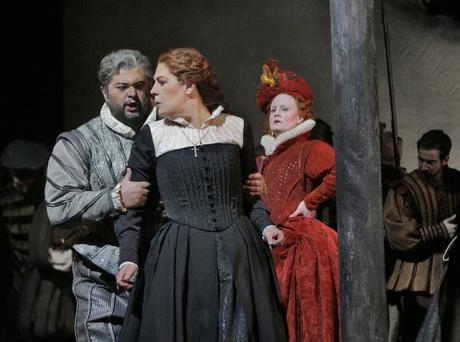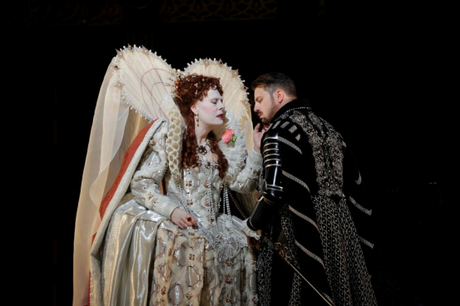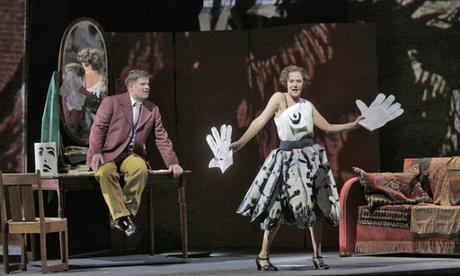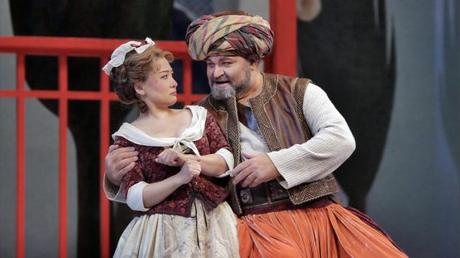Here’s What We Missed
 John Dexter’s colorful set for Mozart’s The Abduction from the Seraglio (Met Opera)
John Dexter’s colorful set for Mozart’s The Abduction from the Seraglio (Met Opera)
We’re back with more tales of operatic woes. One of them being the record number of missed Saturday afternoon radio broadcasts this author has experienced during the course of the past year.
For a die-hard fan, that may be considered anathema. However life — and not just operatic life — has a way of interfering with the normal course of events. I’ve mentioned this truism on various occasions in the past, but lately it has become the rule rather than the exception. If the current U.S. administration’s mania for cutbacks to funding for the arts continues on the path it’s been threatening to go down, will we even have an operatic life to talk about?
Whatever the future holds, let us deal with the here and now. Looking back at the current season, I can’t breed much enthusiasm for the casting in many of the recent Met Opera radio broadcasts. But before we get into that, let me go over old terrain by playing “catch-up,” as I call it, with what I have heard but failed to report.
Starting with the broadcast of February 20, 2016 of Donizetti’s Maria Stuarda, I could tell that bel canto, which Maria Stuarda is a prime example of, was much on the minds of listeners. What transpired over the airwaves was a very fine performance indeed of this rarely heard (at the Metropolitan, at last count) cornerstone of the bel canto repertoire.

Donizetti’s so-called Tudor Trilogy, comprised of Anna Bolena, Maria Stuarda, and Roberto Devereux, has been a showcase for dramatic coloratura sopranos for nearly two centuries. Some of our modern interpreters include Maria Callas, Leyla Gencer, Joan Sutherland, Beverly Sills, Montserrat Caballe, and Mariella Devia. And the stories (greatly embellished, I might add) of the Elizabethan period, involving King Henry VIII, Anne Boleyn, Mary Stuart, Elizabeth I, and Robert Earl of Essex, have been widely depicted in a multiplicity of forms, especially in books and motion pictures (for example, that old 1939 Warner Bros. vehicle The Private Lives of Elizabeth and Essex and the more recent The Other Boleyn Girl from 2008).
Sir David McVicar’s production of Maria Stuarda was staged along the same lines as the previous Anna Bolena, i.e., with drab gray sets offset by stunningly vibrant costumes. In the second part of the trilogy, soprano Sondra Radvanovsky took on the title character, the one who confronts the Virgin Queen Elizabeth, sung by the fiery South African soprano Elza van den Heever in her best Bette Davis mold, and ends up calling her a “vile bastard.” Historically, neither character met, but then there would be no opera as we know it!
Both artists acquitted themselves admirably, but all ears were focused on a remarkable new tenor named Celso Albelo as Leicester. A native of the Canary Islands, where his compatriot, tenor Alfredo Kraus, once hailed from, Albelo scaled the vocal heights in daring if somewhat cautious fashion. Nevertheless, his was the voice that caught the audience’s notice.
At the time, Albelo remarked, to the Latin Post, that he had sung Leicester “at La Scala in Milan, Covent Garden in London and all I was missing was the Met. So to do Maria Stuarda with a composer to whom I owe it all. For me it is a dream.” He went on to indicate that Leicester “is one of those roles that I have found some hidden difficulty. This one has a lot to sing in very little time and the tessitura is high. You need a lot of lyricism in the voice. Sometimes you tend to overdo it and end up going down the wrong path.”
Not likely, for such a budding talent. Albelo managed to tread lightly but securely. His colleagues all put on a commendable showing as well, to include the charismatic baritone Patrick Carfizzi as Cecil and the rumbling bass tones of Kwangchul Youn. While Radvanovsky was the obvious attraction (she looked ravishing and sounded more and more like Callas than ever, minus the wobbles), the other participants showed their mettle, too.

Another demonstrable vocal showcase was put on with the April 16, 2016 broadcast of the third and final work in the series, Roberto Devereux, starring the incredibly pliable tenor of Matthew Polenzani in the lead, along with his frequent stage partner, Polish baritone Mariusz Kwiecien (known as The Pearl Fishers duo), as the Duke of Nottingham. We were also treated to the gloriously sung Sara of Latvian mezzo Elīna Garanča, in addition to the tempestuously acted Elizabeth of the Met’s reigning queen Sondra Radvanovsky, who mitigated her opulent tones somewhat to deliver a fiercely competitive sovereign in the twilight of her reign.
What a Lulu!
I started this post off by mentioning that I had missed several Met broadcasts, one of them being the difficult to appreciate Lulu by Alban Berg. Scheduled for February 27, 2016, this was to be the last time that German soprano Marlis Petersen would be assuming the title role in a new production designed by South African artist and director William Kentridge. Kentridge had earlier brought his highly stylized vision for Shostakovich’s satirical The Nose to the Met’s Russian wing. That production featured the versatile Brazilian baritone Paulo Szot, whose ancestry is Polish.
Kentridge is the type of artist who loves to push the outside of the envelope. Both The Nose and Lulu share a similar theatrical basis, but the music is what differentiates them. Berg’s final stage work was left unfinished at his untimely passing in 1935. A tawdry tale from the pen of playwright Frank Wedekind (whose coming-of-age play, Spring Awakening, was transformed into a hit Broadway musical by Duncan Sheik and Steven Sater), Lulu was derived from two of his works, Pandora’s Box and Earth Spirit. Shorn of its third act (a situation shared with another unfinished 12-tone masterpiece, Schoenberg’s Moses und Aron), the opera was completed in the late 1970s by Austrian composer-producer Friedrich Cerha.

Personally, I have a tough time listening to Lulu. I can’t put my finger on it, but this opera leaves me cold, sad and depressed. There is no joy anywhere — indeed the joy of living has been drained from its very essence. It’s a Lulu, all right; one of the most viciously scandalous and thought-provoking pieces ever to enter the modern repertory. And if you think this one is rough going, try lending an ear to Bernd Alois Zimmermann’s immensely orchestrated and gigantically conceived Die Soldaten (“The Soldiers”), which is even MORE daring and disheartening. But I do digress.
Although I’ve grown accustomed to the defects and virtues of Wozzeck, Berg’s previous output for the stage, I greatly value its harshness and drab realism (one can have actual sympathy for the protagonists and empathize with their plight). It’s the character of Lulu herself that I find most detestable. Sorry, but she’s not my cup of tea.
Lulu meets her end at the hands (or blade, if you will) of the infamous Jack the Ripper. Yikes! Maybe Berg was right to have died prior to completing act three. Some things are better left undone.
Believe it or not, I missed two other bel canto broadcasts: the March 12 performance of Donizetti’s Don Pasquale, with the immensely enjoyable Ambrogio Maestri in the title role and the impressive Mexican tenor Javier Camarena as his nephew Ernesto; and the March 19 transmission of Donizetti’s other comic jewel, L’Elisir d’Amore (“The Elixir of Love”), with the artist of the moment, hunky tenor Vittorio Grigolo, as the country bumpkin Nemorino.
I did catch a moment or two of the March 26 Le Nozze di Figaro (“The Marriage of Figaro”) by Mozart, marvelously conducted by Fabio Luisi. However, the sameness in voice and timbre of the two male leads, Russian basso Mikhail Petrenko as Figaro and Italian bass-baritone Luca Pisaroni as the Count (“One, two, three, ha-ha-ha!”), made for a bit of bewilderment as to who was singing whose lines. Figaro’s two arias, “Se vuol ballare, Signor Contino” and “Non più andrai,” were undistinguishable from one another. More solidity in the low register and a more pointed tone on top — and, especially, a finer sharpening of the words — were called for.
The Joke’s on Us

The final May 7, 2016 broadcast of the 2015-2016 season, Mozart’s delightful The Abduction from the Seraglio (or, in the unpronounceable German translation, Die Entführung aus dem Serail), under the leadership of the ever-resilient maestro James Levine, was a decided disappointment. In the right hands and with the right artists, this opera can make audiences squeal with glee at its comic antics and ever-so-timely statement about the rights of women in a male dominated world.
The Met Opera’s cast featured soprano Albina Shagimuratova as Konstanze (trivia note: she was named after Mozart’s spouse), chirpy coloratura Kathleen Kim as the perky maidservant Blondchen, tenor Paul Appleby as Belmonte, Konstanze’s rescuer, and actor Matthias von Stegmann as the Pasha Selim (the fellow whose harem Konstanze needs to be rescued from).
This always charming, always beguiling work, with its madcap plot and extremes of both comic and dramatic devices — along with its humorous and irrepressible characterizations — lacked spontaneity, even in the gorgeously bedecked production by the late John Dexter. Especially revealing was the slack conducting by Maestro Levine. We were told he had been suffering from the ill effects of recent back surgery, which has been the bane of his conducting assignments at the Met for more than a decade. Take a long and welcome rest, Maestro!
The premise of this piece, something that many viewers and music critics miss, is that The Abduction from the Seraglio, at its core, is a spoof of opera buffa (or “comic opera”). Imagine a huge basso profundo named Osmin — in this case, embodied (literally) by the large economy-sized voice and figure of Hans-Peter König, in a capacious turban and baggy pantaloons — put in charge as the overseer of the Pasha Selim’s harem.
Now here’s the gimmick: this gargantuan guardian of feminine pulchritude was supposed to be neutered! Most such individuals, in actuality, were of African descent and likely castrated upon being given the job, resulting in their massive forms and high, squeaky voices (castration, naturally, would have had an effect on their vocal chords by stunting them). They’re supposed to be eunuchs, people; the reasoning being that eunuchs would be more trustworthy as they were incapable of molesting the “flock,” as it were. Yet here we have a big, booming bass pushing his volume up and down the scale, right into a cavernous low D.
Was this Mozart’s little inside joke, another outstanding example of the Austrian master’s wry sense of humor, and of his going against the accepted grain?
Ah, Wolfie! You are STILL the undisputed master of your musical universe!
(End of Part One … To be continued…)
Copyright © 2017 by Josmar F. Lopes
Advertisements
